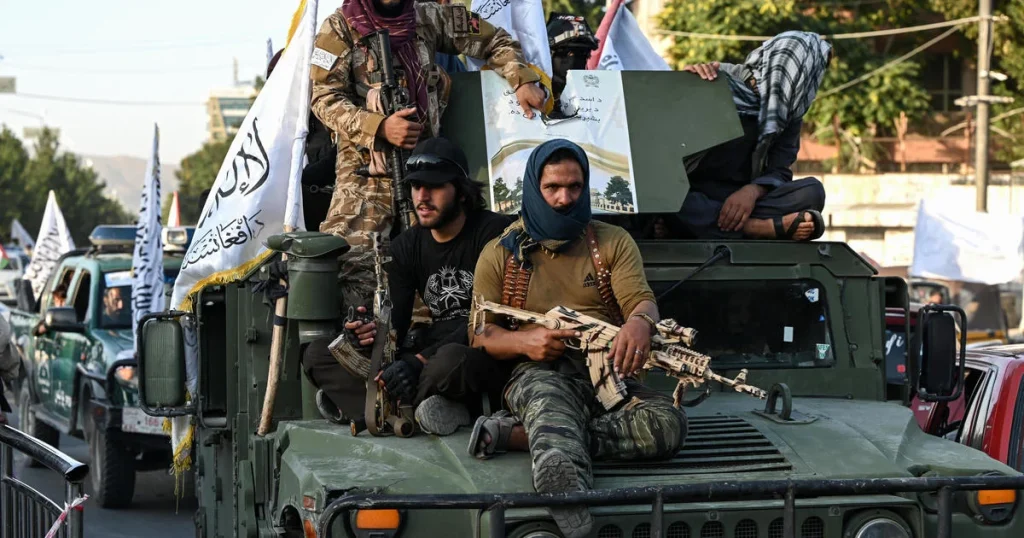During his appearance at the Conservative Political Action Conference (CPAC), former U.S. President Donald Trump unveiled a significant plan to reclaim military equipment left in Afghanistan after the U.S. withdrawal. The assets, now in the hands of the Taliban, have sparked concern over national security and the proliferation of advanced military technology to extremist groups. Trump’s announcement underlines the growing frustration over this situation, which has raised questions about the future of these weapons and their use by terrorist organizations.
U.S. Military Equipment Left Behind
The U.S. withdrawal from Afghanistan in 2021 led to the abandonment of billions of dollars’ worth of military equipment. Much of this gear was seized by the Taliban and has raised security concerns, particularly over its potential use by militant groups. The equipment includes weapons, vehicles, and advanced technologies that were originally intended to support Afghan defense forces.
As of now, the Taliban is believed to possess more than 78 aircraft, 40,000 military vehicles, and over 300,000 firearms. These assets make the Taliban one of the most heavily armed militant groups in the world. The scale of the abandoned military assets is staggering, with the U.S. Department of Defense estimating the value at over $7 billion.
Trump’s Strategy for Retrieval
Trump’s announcement that he plans to recover the military assets left in Afghanistan came as part of his broader strategy for national security. During his CPAC speech, Trump expressed his frustration at the Taliban’s use of U.S. military equipment in public parades and other displays. His statement included sharp criticism: “If we’re going to give them that kind of money, let them give back the military equipment, which they have. They have tanks and trucks and guns and goggles—better than we have. Brand new, right out of the box. It’s unbelievable.”
Trump tasked a U.S. official, referred to simply as “Doug,” with developing a strategy for retrieving the equipment from Taliban control. Although the identity of the official remains unclear, speculation suggests that the person might be Doug Manchester, a prominent businessman and Republican donor. Despite attempts by Afghanistan International to obtain confirmation from the U.S. State Department, there has been no official response regarding the identity of this individual.
The Scope of U.S. Investment in Afghanistan
Between 2002 and 2020, the United States invested a total of $88.61 billion in the Afghanistan Security Forces Fund. This funding aimed to equip and sustain the Afghan National Defense and Security Forces. The goal was to build a self-sufficient Afghan military capable of defending the country from threats. However, after the Taliban’s swift takeover in August 2021, much of this equipment fell into their hands.
Military Equipment in the Hands of Extremist Groups
The implications of this equipment falling into the Taliban’s hands extend beyond Afghanistan’s borders. Reports indicate that some of this military gear is now being sold on the black market, with potential buyers in Afghanistan and Pakistan. These weapons have also found their way into the hands of armed groups in the Middle East and Kashmir, raising concerns about the spread of U.S.-made military technology to areas already rife with conflict.
One troubling example includes the Iranian special forces being spotted with U.S.-made M4 rifles, raising alarms about the proliferation of American weapons in volatile regions. Additionally, there have been reports of ISIS fighters using U.S. weapons, including rifles and other military gear, to carry out attacks in Afghanistan.
The use of American-made military equipment by extremist groups has only increased concerns regarding national security and the broader stability of the region. In particular, the trade of these weapons in Afghanistan’s tribal regions complicates efforts to combat the spread of terrorism and militancy.
Biometric and Identification Tools
Another critical concern is the biometric and identification tools left behind during the U.S. withdrawal. These tools were initially used to track individuals who had worked with U.S. forces or the Afghan government. With the Taliban now in control of these tools, there is a growing fear that they will be used to identify and target former allies of the U.S. and Afghan governments.
The loss of such sensitive equipment further complicates the situation in Afghanistan and raises significant concerns about the safety of those who supported the U.S. presence in the country.
The Challenges of Retrieving Military Equipment
While Trump’s directive to retrieve the military assets from Taliban control reflects a clear stance on the issue, the practical challenges of executing this plan remain unclear. The Taliban’s control over Afghanistan’s military infrastructure and the widespread presence of U.S. military gear in the region make it difficult to devise a feasible strategy for reclaiming these assets.
The scale of the task, coupled with the security challenges posed by the Taliban’s consolidation of power, suggests that any efforts to retrieve the military equipment would face significant obstacles. Moreover, the Taliban’s grip on key military sites and the ongoing political instability in the country make it uncertain whether these assets can be reclaimed at all.
The situation regarding U.S. military equipment left behind in Afghanistan remains a complex and pressing issue. Trump’s proposal to reclaim these assets highlights the ongoing security concerns surrounding the proliferation of advanced military gear to extremist groups. With the Taliban now possessing some of the most advanced military technology, including aircraft, vehicles, and firearms, the stakes are higher than ever.
While Trump’s strategy may be an attempt to address these concerns, the feasibility of reclaiming such a large volume of military assets remains in doubt. As the Taliban continues to consolidate control over Afghanistan’s military infrastructure, the fate of these weapons will have far-reaching implications for both national and global security.


